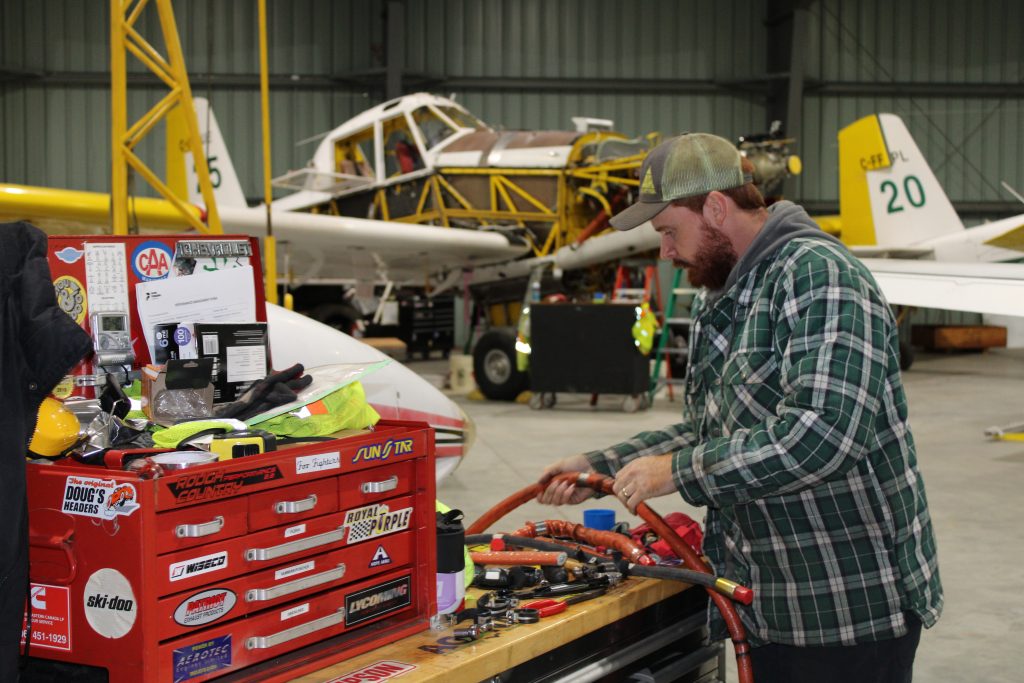As the fire season draws to a close each fall, it comes time to bring our aircraft into the hangar and begin our winter maintenance program. It is no small effort to make sure the fleet is ready for the next flying season. Forest Protection’s aircraft maintenance team spends all winter working to ensure that come spring, our airplanes are in good working order and ready to protect New Brunswick forests.
Inhibiting Process
At the end of our operational season, Forest Protection’s aircraft go through an inhibiting process. Inhibiting prepares the engines and airframe for long-term winter storage. First, the aircraft are cleaned inside and out to remove all the dirt that accumulates during a summer of flying. Next, the batteries, fire extinguisher, emergency locator transmitter (ELT), survival kits and first aid kits are removed and given to our parts department for storage and maintenance.
As for the engines, inhibiting is critical for both piston and turbine engines in order to prevent corrosion. Getting a piston engine aircraft ready for winter storage is accomplished by draining the oil and replacing it with preservative oil. Once serviced with the new oil, an aircraft maintenance engineer (AME) will run up the engines. This allows the oil to work its way through and provide adequate protection to internal components. Lastly, a mist of hot preservative oil is sprayed directly into each cylinder. As the oil cools, it creates a film on the cylinder wall keeping out moisture and protecting the metal underneath.
For our turbine engine-powered Air Tractor AT-802s, the process is different but the end goal is the same. Inhibiting an AT-802 is a two-person job. One AME will be operating the controls in the cockpit while the other will be ready by the engine. The AME in the cockpit will “dry motor” the engine, spinning it over without actually starting it. Meanwhile, the AME outside the airplane will pump preservative oil into the fuel heater, allowing the oil to work its way through and protect the fuel control unit.
Annual Maintenance Inspection
With the aircraft ready for their long winter’s nap, Forest Protection’s aircraft maintenance team gets to work carrying out annual inspections and fixing any snags. The scope of an annual inspection is wingtip to wingtip, and nose to tail. All systems get looked at in-depth by our maintenance personnel, be it the tread of tires, a nick in the propeller, or the welded joints of the fuselage frame.
It all starts with an inspection package, a large document outlining all tasks to be carried out as well as any relevant airworthiness directives (ADs) or service bulletins (SBs). The lead AME will go over this package with their crew, and a plan will be made. The crew will then get to work removing the engine cowlings and access panels to facilitate working on the plane. With the aircraft made ready for maintenance, the real work can begin.
A keen eye is necessary to ensure that our aircraft are safe for flight. Many hours are spent looking at the aircraft with a flashlight and mirror, having a close look for cracked metal, fluid leaks, chafed wires, etc. We take a proactive approach so that if something is not right, it can be fixed before it becomes a bigger issue. An annual inspection requires more than just a mirror and flashlight – some key components need to be removed and sent away to be repaired. For example, when a propellor reaches the end of its time before requiring an overhaul, the AMEs must remove the propellor and disassemble it for shipping to the overhaul facility. These are scheduled maintenance items and are dealt with as the aircraft or component approaches the deadline. Unscheduled maintenance happens anytime an unforeseen issue is found or suspected. It could involve anything from fixing a non-transmitting radio to replacing a damaged section of the aircraft skin. Regardless of the task, our aircraft maintenance team is dedicated, highly trained and well equipped to ensure the airworthiness of our fleet.
De-inhibiting Process
When annual inspections are done it’s time to bring the aircraft out of hibernation. Aerostar engines require the preservative oil to be drained from cylinders, which is accomplished by removing the lower spark plugs and turning the propeller over by hand. The pistons will then force the oil out of the spark plug holes. Air Tractors, which have a turbine engine, will have the preservative oil purged from their fuel control unit. Both types of aircraft will have their batteries, ELTs and all other required equipment reinstalled. With the engines “buttoned up”, an AME will perform a run-up and check for normal operation. Following a successful engine run and with the appropriate paperwork complete, the airplane will be released for a test flight.
No two days in the hangar are ever quite the same, the task at hand will change from day to day and month to month. However, all year round our AMEs can be found hard at work taking care of our aircraft. Whether we are pulling a Piper Aerostar out of storage for flight training, or changing the engine on an AT-802, all aircraft maintenance is carried out safely and professionally. Our AMEs use their knowledge and expertise every day to ensure that Forest Protection’s fleet is ready for the next mission.

